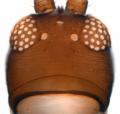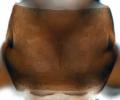Aeolothrips auricestus
Recognition data
Distinguishing features
Both sexes fully winged, or with wings no longer than width of thorax. Body color uniformly brown, or with abdominal segments II–IV, V, or VI sharply yellow; antennal segment II yellow in apical half, III yellow with apex brown; legs brown; fore wings with 2 transverse dark bands. Head and pronotum with no long setae. Fore tarsus apically with stout recurved ventral hamus. Antennae 9-segmented, segment III with linear sensorium short, IV with sensorium less than 0.5 as long as segment and scarcely curved at apex, V–IX forming a single unit with V about equal in length to VI–IX. Median marginal setae on sternites arising at or close to margin, but lateral two pairs arise sub-marginally; sternite VII supernumerary paired setae arise almost medially on disc.
Male without tergal tubercles; setae at base of claspers on tergite IX longer than clasper, without stout curved seta lateral to clasper.
Variation
Described originally as bicolored, with abdominal segments II–VI sharply yellow in contrast to the brown body, this species is considered to exist also in a form with the abdomen uniformly brown (Bailey, 1951).
Related and similar species
A. auricestus often has the basal abdominal segments sharply yellow, as in A. albicinctus and A. brunneipictus that are also known in California. At least two other Aeolothrips species occur in western USA with the abdomen bicolored, A. aureus Moulton and A. bicolor Hinds, and these five species apparently all live at ground level as predators of small arthropods. However, winged females of the brown form of A. auricestus are similar in structure to those of other species in the A. fasciatus group. Just over 90 species are placed currently in the genus Aeolothrips, of which more than 50 are from the Palaearctic Region (mainly Europe), and 28 from the Nearctic (mainly western USA). Only two species are recorded from the Neotropics; the one from Chile is probably the same as A. fasciatus, and one from Panama is probably not a member of this genus (Mound & Marullo, 1996).
Taxonomic data
Current valid name
Aeolothrips auricestus Treherne
Original name and synonyms
- Aeolothrips auricestus Treherne, 1919: 184
Family placement
Aeolothripidae
Biological data
Life history
Presumably predatory on other small arthropods; commonly with reduced wings.
Host plants
Associated with grasses, and presumably living at ground level.
Tospoviruses vectored
None
Crop damage
None
Distribution data
Area of origin
Western North America
Distribution
British Columbia, Washington, Oregon, northern California.






